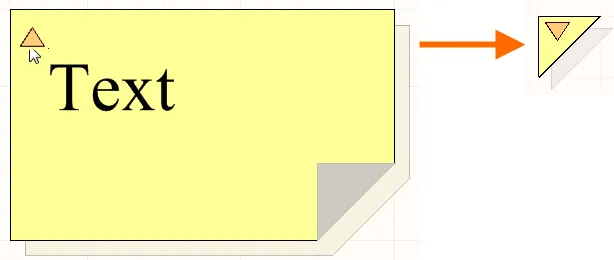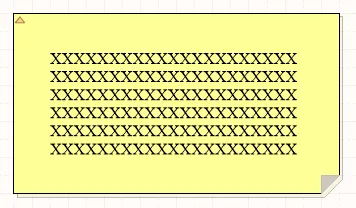Notes are available for placement in the schematic sditor only in the following ways:
- Choose Home | Graphical Elements | Note from the main menus.

- Right-click in the design space then choose Place » Note from the context menu.
After launching the command, the cursor will change to a cross-hair and you will enter note placement mode. Placement is made by performing the following sequence of actions:
- Click or press Enter to anchor the first corner of the note.
- Move the cursor to adjust the size of the note then click or press Enter to complete placement.
- Continue placing further notes or right-click or press Esc to exit placement mode.
Additional actions that can be performed during placement while the note is still floating on the cursor and before its first corner is anchored are:
- Press the Tab key to pause the placement and access the Note mode of the Inspector panel in which its properties can be changed on the fly. Click the design space pause button overlay (
 ) to resume placement.
) to resume placement.
- Press the Spacebar to move the object counterclockwise or Shift+Spacebar for clockwise movement. Movement is in increments of 90°.
- Press the X or Y keys to mirror the note along the X-axis or Y-axis.
Graphical Editing
This method of editing allows you to select a placed note object directly in the design space and change its size, shape or location.
A note can be displayed in either expanded (full-frame) or collapsed (small triangle) modes. Toggle the display mode by clicking on the top left corner of a placed note.

Click the triangle in the top-left corner to collapse a note.
When a fully expanded note object is selected, the following editing handles are available:

A selected Note (fully expanded).
- Click and drag A to resize the note in the vertical and horizontal directions simultaneously.
- Click and drag B to resize the note in the vertical and horizontal directions separately.
- Click anywhere on the note away from editing handles then drag to reposition it. While dragging, the note can be rotated (Spacebar/Shift+Spacebar) or mirrored (X or Y keys to mirror along the X-axis or Y-axis).
When a note is fully expanded, the textual content of that note can be edited in-place by:
- Single-clicking the note to select it.
- Single-clicking again (or pressing Enter) to enter in-place editing mode. Sufficient time between each click should be given to ensure the software does not interpret the two single-clicks as one double-click (which would open the Inspector panel).
- To finish editing in-place text, either click away from the note or press the green tick button (
 ). If you decide the change made is not needed, press the red cross button (
). If you decide the change made is not needed, press the red cross button ( ) to discard the change.
) to discard the change.
The right-click menu provides standard editing commands such as Cut, Copy, and Paste. In addition, if the Word Wrap option is disabled in the Inspector panel, a horizontal scroll bar will also be available when editing the text.

Examples of in-place editing with word wrapping enabled (top)
and disabled (bottom).
The size and shape of a note cannot be changed graphically when it is in collapsed mode; only its location/orientation can be changed. As such, editing handles are not available when a collapsed note object is selected. Click anywhere inside the dashed box and drag to reposition the note as required. The note can be rotated or mirrored while dragging.
To clear the selection of (or de-select) the object, use the Esc key.
Non-Graphical Editing
This method of editing uses the Inspector panel to modify the properties of a note object.

During placement, the Note mode of the Inspector panel can be accessed by pressing the Tab key. Once the Note is placed, all options appear.
After placement, the Note mode of the Inspector panel can be accessed in one of the following ways:
- If the Inspector panel is already open, select the Note, right-click then choose Properties from the context menu.
- With the Note selected, choose View | Schematic | Inspector from the main ribbons.
Editing Multiple objects
The Inspector panel supports multiple object editing, where the property settings that are identical in all currently selected objects may be modified. When multiples of the same object type are selected manually, an Inspector panel field entry that is not shown as an asterisk (*) may be edited for all selected objects.
Wrapping and Clipping Text
In addition to providing a Word Wrap option, the Inspector panel provides a Clip to Area option. This option comes into play if word wrapping is disabled. With this option enabled, text will be kept within the bounds of the note's frame. When disabled, text will spill out of the frame onto the schematic sheet.

Example of word wrapping and the effect of clipping
Specifying Text Margins
Specify a single value to apply equally to Left, Top, Right, and Bottom margins for the current note using the Text Margin field in the Inspector panel.
To benefit from the text margin functionality within the area of the note's frame, ensure that the Clip to Area option is enabled. Ideally, the Word Wrap option also should be enabled.
Negative margins are also possible; use the minus prefix (-).

Example note with a Text Margin setting of 20 (Default DXP Units, equivalent to 200mil).
When editing text in place directly within the note's frame, the defined margins are not present. They will be reapplied after editing is complete and the text changes are applied.

Margins are not shown while graphically modifying the text in-place.
Tip
- While notes can be rotated or mirrored along the X or Y axis, this has no effect on the orientation of the text within.